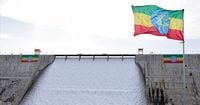On September 9, 2025, Ethiopia marked a turning point in its modern history by officially inaugurating the Grand Ethiopian Renaissance Dam (GERD), the largest hydroelectric facility in Africa. The moment was celebrated across Ethiopia with vibrant festivities, music, and a palpable sense of national pride, as the dam’s turbines began to hum with the promise of transformative power and economic growth. The $5 billion megaproject, perched on the Blue Nile near the border with Sudan, is not just a feat of engineering—it’s a symbol of Ethiopia’s aspirations and a flashpoint in regional geopolitics.
Prime Minister Abiy Ahmed, addressing crowds gathered in Addis Ababa and dignitaries from across Africa, called the dam “a symbol of Ethiopia’s renaissance.” According to Reuters, he emphasized, “It is not built to harm Egypt or Sudan but to light up our homes, power our factories and integrate our region.” The inauguration was attended by dozens of African heads of state and government, including South Sudan’s President Salva Kiir and Kenyan President William Ruto, both of whom expressed intentions to import electricity from the new facility to address their countries’ energy needs.
The technical scale of GERD is staggering. Rising 145 meters above the riverbed and stretching 1,780 meters across, the dam is constructed from over 10 million cubic meters of roller-compacted concrete, according to data from Ethiopia’s Ministry of Water and Energy and Webuild, the lead engineering firm. Its reservoir, among the world’s largest, has a storage capacity of 74 billion cubic meters and, at full pool, covers an area roughly the size of Greater London—about 1,874 square kilometers. When all 13 Francis turbines are operational, GERD will generate up to 5,150 megawatts, enough to double Ethiopia’s national electricity generation and provide power to more than half of its 120 million citizens. At the time of inauguration, six turbines were already running, with full commercial operation expected imminently, as reported by the Financial Times and African Energy.
The dam’s impact extends far beyond Ethiopia’s borders. With agreements already in place to transmit power to Sudan, Djibouti, and Kenya, GERD is poised to make Ethiopia a regional energy powerhouse. Kenya’s President Ruto described the project as a “pan-African statement,” aligning with the African Union’s vision of continental energy connectivity. South Sudan’s President Kiir announced that his country would soon sign an agreement to import electricity from GERD, stating, “We will soon be signing an agreement with the government of Ethiopia to receive electricity from the dam that will benefit our hospitals and schools.”
For Ethiopians, GERD is more than concrete and turbines—it’s a monument to self-reliance. The project was largely financed domestically, with 91% of the $5 billion cost covered by bonds, payroll contributions, and public fundraising. Only about $1 billion, earmarked for turbines and electromechanical systems, came from China’s Exim Bank. Habtamu Itefa, Ethiopia’s Minister of Water and Energy, noted in a ministry briefing that “GERD is unique not only for its scale but for being self-financed by Ethiopians.” More than 25,000 people, mostly Ethiopians, worked on the dam over its 14-year construction, and a new town—with a hospital, schools, clinics, and roads—has sprung up around the site, providing lasting benefits to the region.
The dam’s completion is also closely tied to Ethiopia’s push for electrification and economic modernization. With the country having banned the importation of gasoline-powered vehicles, GERD’s electricity is expected to fuel the growth of electric vehicles and support the expansion of online services. As Belay Tigabu, a bus driver in Addis Ababa, told the Associated Press, “We will have enough power to charge our electric vehicles from the new dam.” University student Yabsira Misganw echoed this optimism, saying the dam “will provide stable electricity and improve online services.”
Yet, GERD’s promise is shadowed by deep regional tensions—especially with Egypt and Sudan, the two major downstream countries that depend on the Nile for nearly all their freshwater needs. Egypt, in particular, has long opposed the dam, fearing that its operation could reduce water flows and threaten the livelihoods of its more than 100 million citizens. Tamim Khallaf, a spokesperson for Egypt’s Ministry of Foreign Affairs, described GERD as an “existential threat,” telling the Associated Press, “There was no prior notification, proper consultations, or consensus with downstream countries, thereby constituting a grave violation of international law.”
Egypt’s concerns are rooted in history and hydrology. The Nile, and especially the Blue Nile rising in Ethiopia, supplies about 60% to 70% of the river’s total flow by the time it reaches Egypt’s Aswan. The country’s reliance on the river was enshrined in colonial-era treaties negotiated by Britain in the 1920s and reinforced by a 1959 agreement with Sudan, which guaranteed Egypt around 80% of the Nile’s water. Rashid Abdi, an analyst at Sahan Research, told the BBC, “Ethiopia is now projecting power, while Egypt’s fortunes have declined. It has lost its privileged status over the Nile.”
Water experts in Egypt claim that the dam has already reduced the amount of water the country receives, forcing authorities to implement short-term measures such as reducing annual consumption and recycling irrigation water, as cited by The Associated Press. Sudan, too, has raised alarms about the risks of uncoordinated water releases, which could trigger either sudden flooding or extended dry periods. According to DW, Sudanese experts say that seasonal flooding has decreased during the dam’s filling, but warn of future unpredictability if cooperation is lacking.
Despite these warnings, Ethiopia’s leadership has repeatedly sought to reassure its neighbors. In his inauguration speech, Prime Minister Abiy Ahmed declared, “I assure you that Ethiopia will never take away your rightful share. Today, I make this promise before my people. The hunger of our brothers in Egypt, in Sudan, or anywhere else is also our hunger. We must share and grow together, for we have no intention of harming anyone.” Ethiopian officials maintain that reservoir filling has been managed to balance their own needs with the flow to downstream countries, and that GERD offers the prospect of “shared development if our neighbors choose cooperation.”
Efforts to reach a legally binding agreement on water flow and dam operation have so far failed, despite the 2015 Declaration of Principles signed by Ethiopia, Egypt, and Sudan. As regional tensions simmer, the dam stands as both a beacon of hope for Ethiopian development and a source of anxiety for its neighbors.
For Ethiopia, the Grand Renaissance Dam is more than just an engineering marvel. It is, as Prime Minister Abiy put it, “the cornerstone of Ethiopia’s future.” Whether it will also become a foundation for regional cooperation—or a flashpoint for conflict—remains to be seen, but its impact on the Horn of Africa is undeniable.


